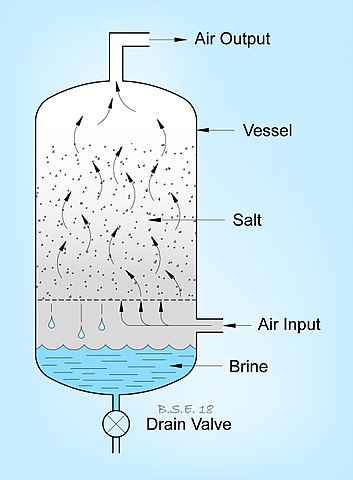Moisture free air is a “must” for industrial use, for a number of reasons:
- An awful lot of distribution systems incorporate iron pipe. It’s inexpensive, readily available, easy to work with, rated for pressure, and has a long history of successful installations. Iron pipe will also oxidize (make rust) in the presence of water:

- Regardless of what your distribution lines and components are made of, water droplets can erode them. Compressed air itself is a gas; it follows the curves in elbows, and flows around valve discs & regulator diaphragms. Water droplets, on the other hand, run full speed INTO those things, often at high velocity. This eventually causes pitting, which is bad enough…those pits, though, are little pockets for salts, acids, or alkalines to effect their destructive little chemical reactions.
- When used for blow off applications, anything in your compressed air will get on anything you’re blowing off. If the intent is to remove moisture from a surface, moisture in your compressed air supply decidedly works against your goal.
- Water can freeze as it is carried along with air flow through orifices. This can quickly block the flow of air. The US Navy lost a submarine, USS Thresher (SSN-593) and all hands in 1963. A number of factors contributed to the sinking, but a significant one was that compressed air being blown into the ballast tanks (to create negative buoyancy) had higher than permissible moisture content, and froze in orifice plates in the lines. The ballast tanks stayed full of water, and 129 sailors & shipyard personnel died as the boat passed crush depth.
There are a number of types of air dryers that are commonly fitted to industrial air compressors to take care of moisture problems. The least expensive one of these is the Single Tower Deliquescent Dryer. Here’s how they work:

- Incoming compressed air enters near the base, where a form of mechanical separation occurs…the air flows back & forth, around trays of desiccant. The simple act of changing direction causes some of the water to just fall out and collect in the bottom.
- The air then flows upwards through the desiccant bed. The desiccant in a deliquescent dryer absorbs moisture (as opposed to the adsorption that occurs in a regenerative desiccant dryer) until they get so wet, they dissolve.
- After the desiccant does its job, moisture free air flows out the top, and gets on with it’s work.
In addition to the low price tag, other things to like about them are:
- Low pressure drop.
- No moving parts or electrical components.
- Can be used outdoors, and in hazardous, mobile, dirty, or corrosive environments.
Of course, there are things to NOT like about them as well:
- Limited suppression of dew point – because they are drying the air to a specific relative humidity, as opposed to a specific dew point, the attainable dew point is dependent on the incoming air temperature, the chemical composition of the desiccant salt, and the ambient temperature where it’s installed. Unless you use some sort of specialty salt desiccant, the typical dew point is only 20-25ºF lower than the air inlet temperature.
- Desiccant carryover – speaking of those specialty salts, they’re even more corrosive than the basic sodium chloride that’s often used. Any carryover will wreak havoc on your distribution system and air operated devices.
Deliquescent dryers’ particular set of “pros and cons” presents challenges for their use in industrial settings, for sure. But if the primary concern is preventing pipes from freezing up, then their low cost, low maintenance, and simplicity make them a great choice.
At EXAIR Corporation, we’re keen on compressed air efficiency. The attention to detail we pay to our products – from design, to manufacturing & assembly, to availability, and right on through to technical support – bears out our commitment to helping you get the most out of your compressed air system. If you’ve got questions, we can talk about this all day long…and most of the time, we do. Give me a call.
Russ Bowman, CCASS

Application Engineer
EXAIR Corporation
Visit us on the Web
Follow me on Twitter
Like us on Facebook
Image courtesy of Brian S. Elliott, Wikimedia Commons Creative Commons Attribution-Share Alike 4.0 International License